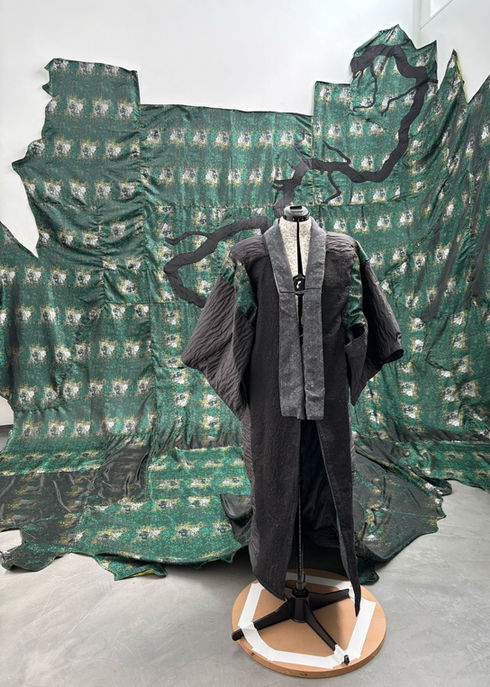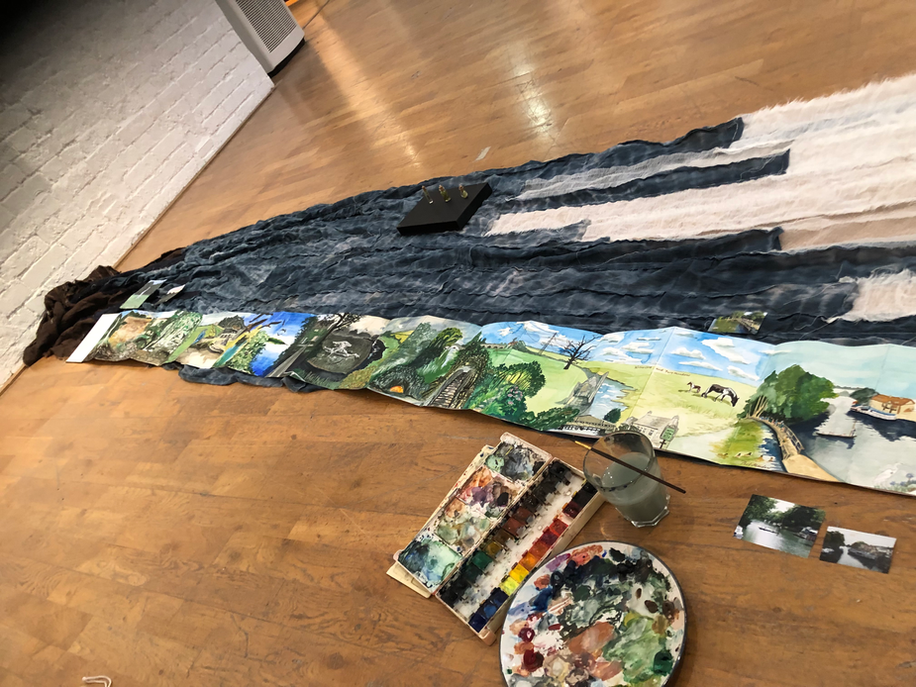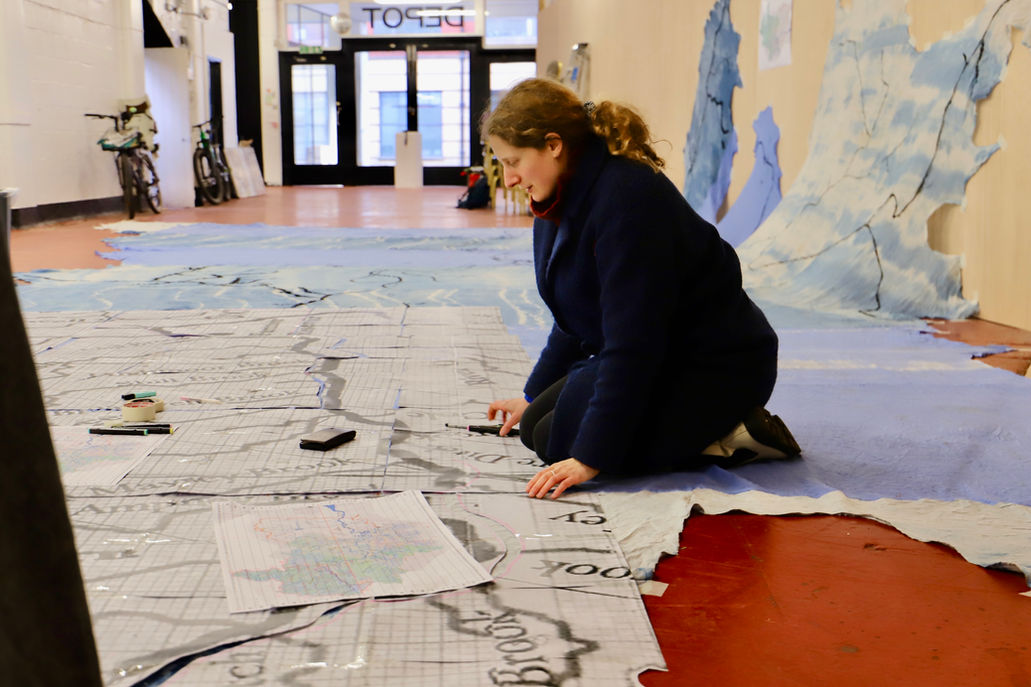A r t > T i m e l i n e
T a m e s i s U n w e a v i n g

T a m e s i s U n w e a v i n g
Tamesis Unweaving explores how our rivers and waterways weave us into our environment and what happens when that connection starts to fray.
It is a community-created 15m long wearable robe which features a to-scale hydrological mapping of the Thames watershed from source to sea. It is composed of 65 pieces of mix-fibre recycled jacquard fabric, with each piece covering one of the many tributaries of the Thames watershed. The rivers themselves are quilted on and made from hand–textured gathered silk. Eventually, each will be fully embroidered by workshop participants to depict their memories, experiences, and stories of the river. The lining, muslin hand-dyed with indigo, will depict the pollution data, sewage leaks, aquatic biodiversity crisis and all the monitoring carried out over the course of the project. Eventually, the robe will look like a single drop of water, when seen from above. It will be assembled piece by piece, tributary by tributary, story by story.
The workshops are being co-run with Dr. Pablo Fernandez Velasco, a cognitive scientist from the Centre for the Sciences of Place and Memory, University of Stirling, who researches ecological emotions, and with Teyah Payne a political ecologist with a focus in water equity and access. She is a research assistant at Kings College Water Centre.
Tamesis, the ancient name of the Thames river, means dark waters. Today those waters are muddied and their ecosystems put under threat by continual raw sewage spillage, agricultural run-off, antibiotic and fertility inhibitor pollution and micropollutants, such as plastics.
On the local level, outrage is mixed with an acute sense of loss, which can be hard to address without a determined subject of loss or a pathway to action. We have lost track of the number of headlines of lawsuits against ThamesWater (the Oxfordshire and Greater London water provider) and the constant discoveries of covered-up sewage leaks. Locals report feelings of impotence in facing the water company, disempowerment, frustration and grief. This art-science project provides a framework for talking about and processing this ecological grief, putting names to undefined feelings, re-stitching our connections to the more-than-human-world in an approachable, accessible way, and helping communities find pathways towards taking action, through citizen science, art, and activism. The project consists of a long series of workshops that began in 2024 in schools, museums and culture institutions (such as Modern Art Oxford, the Old Fire Station, the Ashmolean Museum, The University of Oxford Museum of Natural History, The Bodleian Library, MakeSpace, Science Gallery London, the Botanic Gardens, Oxford) as well as workshops in community spaces and out on the rivers across the watershed.
These workshops combine citizen science water-quality monitoring, story-telling, video work, and a communally created textile artwork, which weaves together experiences of environmental loss, hope and community resistance across the watershed.
The Tamesis Unweaving piece emerged from the artist's participation in the grassroots organisation OCRI (Oxford Clean Rivers Initiative) that she and other local activists founded in 2023 to address growing concerns about river pollution, joining forces with established groups like WASP and the Evenlode Catchment partnership. Gleizer has continued to work with EarthWatch, Thames21, and RiverAction on protests, organising town-halls, sit-ins, and citizen science monitoring courses.
The project is supported by Modern Art Oxford, The Museum of Climate Hope, The Schwartzman Centre for Humanities, University of Oxford, the School of Geography, University of Oxford, GLAM, Right Here Right Now symposium, The Oxford Cultural Programme, Fusion Arts, The Old Fire Station, and the University of York.

Upcoming Exhibitions
Tamesis Unweaving Exhibition at the Old Fire Station Gallery
https://oldfirestation.org.uk/exhibitions/tamesis-unweaving/
1 April - 17 May
40 George St, Oxford OX1 2AQ
Right Here Right Now Exhibition at the Weston Library
30 May - 5 June
Broad Street, Oxford OX1 3BG
Fusion-Multaka Exhibition at Depot Gallery
7 June - 10 June
15 Park End Street
Upcoming Workshops
12 April Continuing Education Oxford 9:45-1pm
https://www.conted.ox.ac.uk/courses/climate-change-creative-and-hopeful-responses?code=O24P178SOJ
9 May Science Gallery London 2pm
https://www.eventbrite.co.uk/e/tamesis-unweaving-tickets-1235977053639?fbclid=IwY2xjawJ4eGlleHRuA2FlbQIxMABicmlkETAxWWI3ZG1STkpkYVc3RGtQAR7lUyLNoz1JSYeo6jUIKyYJguODH3D1p_iFsLYK22eCKK-J63m7wyVJdT1QKQ_aem_4kUAalewq_UEyESfQlw1xg
6 June Museum of Natural History, Oxford 7pm
7 June Old Fire Station, 10-12 Oxford
https://oldfirestation.org.uk/exhibitions/tamesis-unweaving/
7 June University of Oxford Botanic Garden and Arboretum 1:30pm
8 June Ashmolean Museum 1-4pm
5 July MakeSpace Oxford 12:30-4pm
https://www.eventbrite.co.uk/e/tales-of-the-thames-uncovering-stories-with-arts-citizen-science-tickets-1306838873249



























